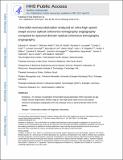Choroidal Neovascularization Analyzed on Ultrahigh-Speed Swept-Source Optical Coherence Tomography Angiography Compared to Spectral-Domain Optical Coherence Tomography Angiography
Author(s)
Novais, Eduardo A.; Louzada, Ricardo N.; Dang, Sabin; Regatieri, Caio V.S.; Witkin, André J.; Baumal, Caroline R.; Hornegger, Joachim; Jayaraman, Vijaysekhar; Duker, Jay S.; Waheed, Nadia K.; Adhi, Mehreen; Moult, Eric Michael; Cole, Emily D.; Husvogt, Lennart; Lee, ByungKun; Fujimoto, James G; ... Show more Show less
DownloadChoroidal neovascularization.pdf (760.0Kb)
PUBLISHER_CC
Publisher with Creative Commons License
Creative Commons Attribution
Terms of use
Metadata
Show full item recordAbstract
Purpose
To compare visualization of choroidal neovascularization (CNV) secondary to age-related macular degeneration (AMD) using an ultrahigh-speed swept-source (SS) optical coherence tomography angiography (OCTA) prototype vs a spectral-domain (SD) OCTA device.
Design
Comparative analysis of diagnostic instruments.
Methods
Patients were prospectively recruited to be imaged on SD OCT and SS OCT devices on the same day. The SD OCT device employed is the RTVue Avanti (Optovue, Inc, Fremont, California, USA), which operates at ∼840 nm wavelength and 70 000 A-scans/second. The SS OCT device used is an ultrahigh-speed long-wavelength prototype that operates at ∼1050 nm wavelength and 400 000 A-scans/second. Two observers independently measured the CNV area on OCTA en face images from the 2 devices. The nonparametric Wilcoxon signed rank test was used to compare area measurements and P values of <.05 were considered statistically significant.
Results
Fourteen eyes from 13 patients were enrolled. The CNV in 11 eyes (78.6%) were classified as type 1, 2 eyes (14.3%) as type 2, and 1 eye (7.1%) as mixed type. Total CNV area measured using SS OCT and SD OCT 3 mm × 3 mm OCTA were 0.949 ± 1.168 mm² and 0.340 ± 0.301 mm², respectively (P = .001). For the 6 mm × 6 mm OCTA the total CNV area using SS OCT and SD OCT were 1.218 ± 1.284 mm² and 0.604 ± 0.597 mm², respectively (P = .0019). The field of view did not significantly affect the measured CNV area (P = .19 and P = .18 for SS OCT and SD OCT, respectively).
Conclusion
SS OCTA yielded significantly larger CNV areas than SD OCTA. It is possible that SS OCTA is better able to demarcate the full extent of CNV vasculature.
Date issued
2016-02Department
Massachusetts Institute of Technology. Institute for Medical Engineering & Science; Massachusetts Institute of Technology. Department of Electrical Engineering and Computer Science; Massachusetts Institute of Technology. Research Laboratory of ElectronicsJournal
American Journal of Ophthalmology
Publisher
Elsevier
Citation
Novais, Eduardo A.; Adhi, Mehreen; Moult, Eric M. et al. “Choroidal Neovascularization Analyzed on Ultrahigh-Speed Swept-Source Optical Coherence Tomography Angiography Compared to Spectral-Domain Optical Coherence Tomography Angiography.” American Journal of Ophthalmology 164 (April 2016): 80–88 © 2016 Elsevier Inc
Version: Author's final manuscript
ISSN
0002-9394